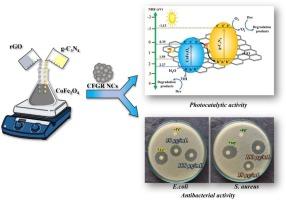CoFe2O4/g-C3N4/氧化石墨烯三元复合材料光催化降解有机污染物的研究
IF 5.1
3区 材料科学
Q2 MATERIALS SCIENCE, COATINGS & FILMS
引用次数: 0
摘要
采用水热法制备了CoFe2O4/g-C3N4/还原氧化石墨烯纳米复合材料。对所得材料的结构、形态和光学性质进行了全面表征,并对其光催化性能进行了评价。XRD分析证实合成的纳米复合材料形成了多晶结构。FESEM和HRTEM分析显示纳米级颗粒具有明确的形态,证实了三元复合材料的成功形成。以靛蓝胭脂红(IC)和亚甲基蓝(MB)染料为模型污染物,在光照下进行了光催化降解实验。CoFe2O4/g-C3N4/rGO纳米复合材料具有优异的光催化活性,对IC的降解效率为96.99%,对MB的降解效率为95.98%,对应的反应速率常数为0.0235 min−1,对MB的降解速率为0.0255 min−1,表明该光催化剂具有良好的降解动力学。活性的增强是由于复合材料中有效的电荷分离和跨异质结界面的转移。自由基捕获实验表明,羟基自由基(•OH)在降解机制中起主导作用,超氧自由基(•O2−)和光生空穴(h+)也起重要作用。CoFe2O4/g-C3N4/还原氧化石墨烯纳米复合材料对大肠杆菌和金黄色葡萄球菌具有显著的杀菌活性,对污染水体中的有机污染物具有优异的光催化降解性能,在环境修复和抗菌方面具有广阔的应用前景。本文章由计算机程序翻译,如有差异,请以英文原文为准。

Synergistic enhanced photocatalytic performance of CoFe2O4/g-C3N4/rGO ternary nanocomposites for the efficient degradation of organic contaminants
CoFe2O4/g-C3N4/rGO nanocomposites were successfully synthesized by the hydrothermal process. The structural, morphological, and optical properties of the resulting materials were comprehensively characterized and the photocatalytic performance was evaluated. XRD analysis confirmed the formation of a polycrystalline structure in the synthesized nanocomposites. FESEM and HRTEM analyses revealed nanoscale particles with well-defined morphology, confirming the successful formation of the ternary composite. Photocatalytic degradation experiments were conducted under light irradiation using Indigo Carmine (IC) and Methylene Blue (MB) dyes as model pollutants. The CoFe2O4/g-C3N4/rGO nanocomposite exhibited excellent photocatalytic activity, achieving degradation efficiencies of 96.99 % for IC and 95.98 % for MB. The corresponding reaction rate constant were calculated to be 0.0235 min−1 for IC and 0.0255 min−1 for MB, indicating the high degradation kinetics of the photocatalyst. The enhanced activity is attributed to effective charge separation and transfer across the heterojunction interfaces within the composite. Radical trapping experiments revealed that hydroxyl radicals (•OH) played a dominant role in the degradation mechanism, while superoxide radicals (•O2−) and photogenerated holes (h+) also contributed significantly. The CoFe2O4/g-C3N4/rGO nanocomposites revealed significant bactericidal activity against Escherichia coli and Staphylococcus aureus along with excellent photocatalytic performance for degrading organic pollutants in contaminated water, highlighting their promise for both environmental remediation and antimicrobial applications.
求助全文
通过发布文献求助,成功后即可免费获取论文全文。
去求助
来源期刊

Diamond and Related Materials
工程技术-材料科学:综合
CiteScore
6.00
自引率
14.60%
发文量
702
审稿时长
2.1 months
期刊介绍:
DRM is a leading international journal that publishes new fundamental and applied research on all forms of diamond, the integration of diamond with other advanced materials and development of technologies exploiting diamond. The synthesis, characterization and processing of single crystal diamond, polycrystalline films, nanodiamond powders and heterostructures with other advanced materials are encouraged topics for technical and review articles. In addition to diamond, the journal publishes manuscripts on the synthesis, characterization and application of other related materials including diamond-like carbons, carbon nanotubes, graphene, and boron and carbon nitrides. Articles are sought on the chemical functionalization of diamond and related materials as well as their use in electrochemistry, energy storage and conversion, chemical and biological sensing, imaging, thermal management, photonic and quantum applications, electron emission and electronic devices.
The International Conference on Diamond and Carbon Materials has evolved into the largest and most well attended forum in the field of diamond, providing a forum to showcase the latest results in the science and technology of diamond and other carbon materials such as carbon nanotubes, graphene, and diamond-like carbon. Run annually in association with Diamond and Related Materials the conference provides junior and established researchers the opportunity to exchange the latest results ranging from fundamental physical and chemical concepts to applied research focusing on the next generation carbon-based devices.
 求助内容:
求助内容: 应助结果提醒方式:
应助结果提醒方式:


